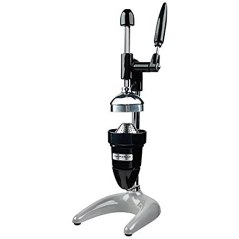
Buyers seeking an exceptionally efficient product will fall in love with this remarkably easy-to-use citrus juicer.
Buyers seeking an exceptionally efficient product will fall in love with this remarkably easy-to-use citrus juicer.
Customers rave over the clean juicing process this product provides. Comes apart easily for cleaning. Lasts for years. No splattering when juicing.
Some customers wished the product came with extra strainers.
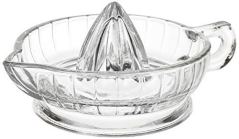
Perfect for customers seeking a simple citrus juicer with an inexpensive price tag.
Perfect for customers seeking a simple citrus juicer with an inexpensive price tag.
Heavy-duty glass built to last against time and citric acid. Includes a deep base for catching citrus juice. Built-in pour spout makes for simple serving. Product is especially easy to clean.
Smaller-sized juicer than some buyers were expecting.
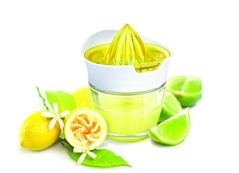
Doubling as a pour spout and handy storage container, this multi-functional product impresses all around.
Doubling as a pour spout and handy storage container, this multi-functional product impresses all around.
Base is made of glass for a quality look and durability. Built-in pouring spout located in juice reamer. Includes an attachable lid for storage. Extremely simple to disassemble and clean.
A few customers had issues connecting the lid to the glass jar.
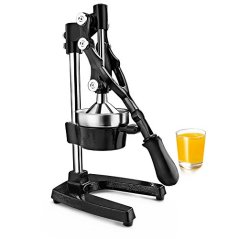
This nearly professional-grade juicer is a great pick for buyers seeking a quality product at a cheaper cost.
This nearly professional-grade juicer is a great pick for buyers seeking a quality product at a cheaper cost.
Crafted from high-quality cast iron and stainless steel. Heavy base and suction feet keeps product from moving when in use. Sturdy construction. Works great with larger fruits.
Some buyers had trouble with the product tipping forward when pushing the handle down.
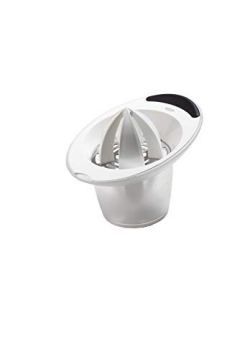
This double-sided juicer is a great choice for buyers seeking a no-nonsense product to handle citrus of all sizes.
This double-sided juicer is a great choice for buyers seeking a no-nonsense product to handle citrus of all sizes.
Includes 2 reamers of different sizes for efficiently juicing fruit of all shapes. Disassembles nicely for easy cleaning. Dishwasher safe. Rubber footing keeps juicer in place.
Sometimes has problems draining liquid quickly. Tends to rip large chunks off of fruit when using.

We recommend these products based on an intensive research process that's designed to cut through the noise and find the top products in this space. Guided by experts, we spend hours looking into the factors that matter, to bring you these selections.

With all the gadgets and high-tech kitchen tools available today, there’s something appealing about returning to simplicity. Manual citrus juicers are classic complements to the modern kitchen, and may even evoke nostalgic memories of a father or grandmother making fresh-squeezed orange juice when you were growing up. Regardless, these non-motorized juicers for citrus fruits are easy to use, easy to clean up, and last a long time. Rest assured, these implements work just as well as fancy electric juicers.
There are a few different types of manual citrus juicers available on the market: squeezers, reamers, and presses. Squeezers and reamers require a bit of elbow grease, while presses require less physical effort but cost more.
If you’re not familiar with the different types and want to learn more, keep reading our guide. If you’re pressed for time, check out our top picks.

If you’ve ever tried to squeeze a lemon or lime into a recipe by hand, you know it can be messy, hard to get all the juice out, and nearly impossible to prevent seeds from dropping into the guacamole or salad dressing you’re preparing. This is where a manual juicer comes in handy, especially if you need to juice just a couple citrus fruits.
A quality manual citrus juicer extracts all the fruit’s juice while straining out the seeds and pulp. For everyday use in the kitchen, you’d be surprised how many recipes call for the juice of a lemon, lime, or orange, making it a hassle to get out the high-tech juicer.
That being said, there are manual juicers that can tackle a big bag of lemons for your kid’s lemonade stand.
The simplest of the manual citrus juicers is the handheld squeezer. This inexpensive tool is foolproof to use and clean. However, it does require the most hand and arm strength. Squeezers are great because they only require one swift movement to juice half the fruit, and their drainage holes catch most seeds and pulp. They also stash away easily in a drawer.
There are two different types of reamers: handheld and countertop.
A handheld reamer is the simplest of juicing tools, and some are even made of wood. This inexpensive, minimalist tool consists of a teardrop-shaped handle and a ridged head. The reamer head is manually turned into the fruit with one hand, while the other hand holds the fruit. This can be as messy as squeezing the fruit by hand. Handheld reamers also don’t catch seeds unless a seed catcher is attached, which some models offer.
A countertop reamer has the ridged head of the handheld version but is attached to a moat to catch the juice. This is less messy but does not eliminate pulp and seeds unless there’s a strainer or sieve attached. Models with strainers have a separate receptacle to catch the juice and often of a bigger capacity than the standard one-piece moat version. Some even double as measuring cups.
Juice presses that come on a stand are great for juicing larger quantities of citrus, like for a pitcher of OJ or lemonade. They use leverage and gravity, so all you have to do is pull down a handle and every drop of juice is extract from the fruit. This effective manual juicing method comes at a higher price tag, not to mention the unit takes up counter space. However, it’s designed for all citrus fruit sizes and separates seeds and pulp from the juice.
Metal: Handheld squeezers are often made from stainless steel or enameled aluminum. With ones that are enameled in colors, select a lead-free coating. Metal handheld squeezers are sturdy and durable. Presses are also constructed from metal, often heavy-duty cast iron with stainless steel components. There are some handheld reamers made from stainless steel.
Glass/ceramic: Some countertop reamers are constructed from heavyweight glass. This is a classic version of the standard type of countertop reamers (with the attached moat). Ceramic is a material also used in designs for countertop reamers but it can be quite fragile.
Plastic: Handheld squeezers also come in plastic. Though lighter, these can require more manual effort to work than metal squeezers. Reamers, both handheld and countertop, are constructed from plastic. Whenever possible, select a food-grade, BPA-free plastic.
Because juicing citrus can be a messy, sticky process, selecting a manual juicer that’s no fuss to clean is recommended. Pieces or parts you can throw into the dishwasher are the easiest to clean, as are one-piece juicers.
You should always follow the cleaning instructions that come with your product, but generally speaking, the following types of manual juicers are dishwasher safe (often recommended by the manufacturer for the top shelf):
Most handheld squeezers, metal and plastic
Some handheld plastic reamers
Glass countertop reamers
Some countertop plastic reamers
Removable parts of some presses
Wood is never dishwasher safe, and stainless steel is iffy.
Another factor that determines how easy a unit is to clean is the number of component parts that need to be washed separately. Presses have the most parts. Consider that sieves and strainers that collect pulp and seeds are a hassle to clean.
The three most commonly squeezed citrus fruits are limes, lemons, and oranges. These three fruits vary in size, and while all reamer types can accommodate their individual circumferences, squeezers and presses are a different story.
For squeezers, we recommend one with tiers: one with a perforated bowl that fits limes and small lemons, and another bowl that fits larger lemons and smaller oranges. Of course, if you only need a squeezer for limes or lemons, by all means select a smaller squeezer designed for that fruit.
Double-sided reamers are also a nice option. They come with two different-size ridged points for more refined juicing: a smaller reamer for limes/lemons and a larger one for oranges.
Presses with five-inch diameters accommodate most citrus fruits, including grapefruits. Because of their heftier price tag, check the press’s measurement before purchasing to be sure the unit will fit the types of citrus you plan on juicing.
An important feature of any citrus juicer is its ability to catch seeds so they don’t end up in the juice. Not all reamers do this, so look for two-piece reamers that either have a seed-catcher attachment or a strainer/sieve separating the container from the reamer.
Manual citrus juicers range in price from $6 to $200.
Inexpensive: Low-priced juicers range in price from $6 to $9. These include handheld reamers and handheld squeezers. Some countertop reamers, usually plastic, can also be found at this price point.
Mid-range: Mid-priced juicers range in price from $10 to $26. Handheld squeezers made from quality materials and two-piece countertop reamers fall into this range.
Expensive: Higher priced juicers are primarily presses. They start at $50 and can run up to $200 for top-of-the-line models.
For instant OJ, put your cup in place of a collection container under a manual press. Seeds will automatically be strained out of the oranges in the process, so your juice will be ready for drinking.
To prevent slipping and sliding, select handheld squeezers with rubberized handles. Wood reamers are also easier to grip than plastic or stainless steel ones.
Consider how much storage space you have in your kitchen when purchasing a manual juicer. Presses are nice statement pieces if you have the counter space, but reamers and squeezers are better suited for smaller kitchen spaces.
If you juice often and in large quantities, invest in a quality press. They’re built to last years longer than electric juicers and are something you can pass onto your kids.

Q. What’s the best manual citrus juicer to make a pulpy OJ?
A. Manual citrus juicers that don’t have strainers deliver pulpier juice. This includes standard and handheld reamers. Squeezers and presses don’t give you pulp and neither do reamers with strainers or seed catcher attachments. Be aware that the reamers that give you pulp in your juice also give you seeds.
Q. Will a manual crank juicer work on citrus?
A. Most manual crank juicers are designed to work on citrus fruits, particularly oranges. The advantage of these types of juicers is that they also work on non-citrus fruits, like apples, and also on vegetables and wheatgrass. There are a handful of affordable plastic models on the market. However, this type of juicer has multiple parts to clean up after juicing and units can be bulky.
Q. What are the advantages of a manual citrus juicer over an electric one?
A. Manual citrus juicers tend to have fewer moving parts than electric ones because they rely on your muscle power. This means they have fewer parts that can break down. Handheld manual juicers are easier to take on the road if you want to keep your healthy diet up while you’re traveling, and they also take up less space in the kitchen. Generally, manual citrus juicers are easier to clean than electric ones, and they’re certainly quieter.
Get emails you’ll love.
Learn about the products you’re wondering if you should buy and get advice on using your latest purchases.
